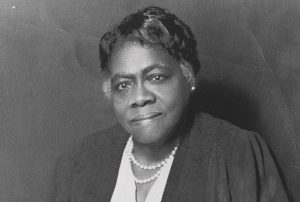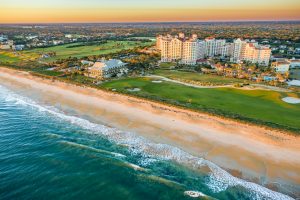Florida depends on visitors staying in hotels, eating at restaurants and exploring the many wonders the Sunshine State has to offer. When the Covid-19 pandemic effectively shut down travel, the tourism industry braced for its biggest challenge ever.
Once-bustling resorts were suddenly empty. Tourism-dependent businesses along Florida’s beaches and in other vacation spots either shut down temporarily, adapted to the pandemic or closed for good, while theme parks and attractions put operations on hold.
While all industries took a hit from Covid-19, none suffered more than tourism.
As the world emerges – tentatively and with some fits and starts – into a post-pandemic era, the outlook for tourism development, and the economy in general, is considerably brighter.
Still, most tourism industry officials agree that there is more work to be done.
“The tourism/hospitality sector is still suffering from effects caused by the Covid-19 pandemic,” said Dana Cameron Jones, President of the Putnam County Chamber of Commerce. “Most of the challenges today are pandemic-related, i.e., people are not traveling as much, events are slow to restart due to uncertainty, and a lack of employees ready to return to work.”
The shortage of employees is being felt in tourist destinations across the North Florida region, said Flagler County Tourism Development Director Amy Lukasik.
“The workforce shortage is a huge concern,” she said. “I recently read an article that in Myrtle Beach they were very concerned prior to the summer because the hotels were already nearing 100% capacity and they didn’t have enough workers.”
Lukasik said labor issues have raised concerns about service levels and guest expectations as more destinations reopen for visitors.
“There’s a pent-up demand for travel and we continue to ask people for a little bit of grace some days,” she said. “That’s the biggest concern I’m hearing, that’s the focus, the labor shortage.”
While the impact of the pandemic is a major factor in the evolving employment landscape, in some ways the tourism industry is a victim of its own success.
“As demand has recovered, so has the need for a high-quality workforce,” said Gil Langley, CEO of the Amelia Island Convention & Visitors Bureau. The issue is exacerbated by the changing demographics in the available workforce pool.
“Given that Amelia Island’s population average is 50-plus, we are becoming a retired-resident workforce, which has resulted in significant difficulties in filling jobs in the hospitality industry,” Langley said. “A related factor is the inability to recruit foreign visa-waiver workers since travel to the United States is only allowed from a few non-traditional countries.”
Lukasik in Flagler County said the recovery of the tourism sector and optimistic projections for future growth have helped push the overall recovery from the pandemic.
“Florida has been open for a while, so we recovered a lot faster than other states,” she said. “Tourism was the first industry to bring back the economy and communities. Sometimes that gets forgotten.”
The view from above
While leisure travel is picking up, a new forecast from the U.S. Travel Association said it will take longer for business travel to return to pre-pandemic levels.
“With vaccinations andrestrictions lowered and traveler confidence rebounding, domestic leisure travel is projected to reach 99 percent of its pre-pandemic peak in 2022 and to grow steadily thereafter,” the report said.That forecast may change given the recent appearance of the Delta variant and rising infection rates.
However, business-related travel is not expected to surpass pre-2020 levels until 2024, according to the report.
While business travel is forecast to increase more than 32% this year, it comes after a year when business-related trips were down nearly 68%. Leisure travel’s more modest 21% increase in 2021 is balanced against a decline of just over 23% the previous year.
As for travel spending, after falling to $55 billion in 2020, vacationers are expected to shell out $671 billion this year for leisure travel and $718 billion in 2022, according to the travel trade group. Business travel spending is anticipated to reach $116 billion this year, after falling to $88 billion in 2020.
When it comes to jobs, the tourism industry is one of the largest employers in Florida.
Statewide nearly 14% of the workforce in the Sunshine State isin the tourism and hospitality sector. For many of the counties in the North Central Florida region that number is even higher.
Just over 19% of Flagler’s workforce is in tourism-related positions while nearly 21% of all private jobs in St. Johns County are in the tourism sector. Nassau County tops the list with almost a quarter of all private-sector jobs related to hospitality and tourism. For Putnam County the number is a bit lower at just under 13% but still a sizeable portion of the total workforce. Tourism industry jobs also make up a significant portion of the workforce in Baker and Clay counties at 11.6% and 16.3% respectively.
From a statewide perspective,things are improving as well, according to Dana Young, President and CEO of VISIT FLORIDA.
“Florida is outperforming the national average in all key performance indicators, including hotel demand, traveler spending and domestic air capacity, which is up over 15% from 2019,” she said. “We are confident that second-quarter visitation estimates will show further positive growth when they’re released in the coming weeks.”
Young said while state economists estimate tourism will not fully recover until 2024, “the progress we have made so far represents a remarkable rebound that has us on track to beat those projections.”
One of the reasons for the state’s strong tourism picture is the effort to market Florida to travelers.
“Florida being open and the only state up until very recently doing any advertising to visitors outside its borders, has put us in a very strong position to now capitalize on the pent-up demand for travel,” Young said. “While border closures, labor shortages, and the ever-evolving nature of the pandemic continue to pose challenges, the steps we have taken as an industry have put us in the best possible position to overcome them.”
Open for business
Lukasik said one factor that helped Flagler County was the vacation rental piece of the tourism puzzle.
“We started showing signs of a very aggressive recovery faster than even our neighbors to the north and south,” she said, referring to the bigger tourism destinations in St. Johns and Volusia counties. “And I believe a lot of that had to do with our strong vacation rental property product we have, and because they are the type of vacation rentals that command a high average daily rate. The vacation rental product is the one that carried us.”
According to Lukasik, Flagler’s tourist development tax revenue – also called the bed tax – is up 40% through May compared with the same period last year. While the pandemic shutdown in 2020 skews those numbers, when compared to the same period in 2019 county bed tax collections are up a still healthy 14.2%.
The same thing is happening in Putnam County, Jones said.
“Fortunately, large projects at local industries have helped increase occupancy rates and created additional customers for restaurants and other hospitality-related businesses,” she said. “Pre-pandemic tourism was rapidly increasing in both number of visitors and events. Now that things have opened up, our hotels, other accommodations providers and restaurants are doing better.”
Things are also picking up in Nassau County, according to Langley.
“Recovery has been faster than expected in both the leisure market and the meeting business at our destination resorts,” he said. “High demand at lodging facilities has resulted in record average rates while the shortage in the workforce has put upward pressure on labor costs, creating more discretionary income, which has a positive impact on the county’s overall economy.”
Looking to sustain the positive momentum, some of the tourism agencies are gearing up their marketing efforts to meet the growing demand for travel.
“Now is a perfect time to market our county as an outdoor recreational paradise as people are changing how and where they choose to go on vacations and weekend getaways,” Jones said. “We began an outdoor-focused campaign that speaks to safe activities and social distancing.”
Jones said her organization has also done some national television advertising with several digital campaigns targeted to specific markets and has a new program coming out in the next month or so to enhance efforts to attract visitors.
In Nassau County, the marketing efforts have “stayed the course” Langley said, focusing on programs that have worked in the past to encourage high-value customers that typically stay longer and spend more money.
“We have curtailed efforts targeting short-term drive markets and re-energized fly markets from the Midwest and Northeast which provide a higher-yield visitor,” he said. “With restrictions anticipated to be lifted shortly from Canada and the United Kingdom, we will begin promotions there in the near future.”
While the past 18 months have been difficult for the tourism industry, Visit Florida’s Young said the resilience of the state’s tourism industry – which faces the threat of hurricanes and wildfires and other natural disasters – provides a strong foundation for the future.
“Though the Covid-19 pandemic is the biggest crisis we have ever faced, Florida tourism is no stranger to crisis,” she said. “From hurricanes to oil spills to terrorist attacks we have seen it all and it has only made us stronger. The resiliency of Florida’s tourism marketers is what fuels our ability to adapt and evolve, so we can continue delivering amazing vacation experiences, no matter what.”










